Frequency Control Strategy for Black Starts via PMSG-Based Wind Power Generation
Abstract
:1. Introduction
2. Research Background and Key Issues of WPG Participating in Black Starts
2.1. Current Situation of the Electric Network in Jiangsu Province, China
2.2. Key Issues of WPG Participation in Black Starts
2.2.1. Selection of the Wind Turbines
2.2.2. Selection of the Startup Power Supply
2.2.3. Start Time of the Static Synchronous Compensator
2.3. General Procedure of Black Start by PMSG-Based WPG
- (1)
- A mobile diesel power generation is connected to the 35-kV bus of the wind farm and starts to supply power. This mobile diesel power generation is used as the main reference source in the black start process to provide stable voltage amplitude and frequency reference for isolated systems. By adjusting the port voltage amplitude of the diesel generator, the diesel generator is able to realize the raising voltage from zero. When the diesel generator is started, the no-load charging of the box type transformer in the wind farm is completed.
- (2)
- STATCOM is started after its capacitances and control system are charged through the 35-kV bus to provide voltage support for the isolated system.
- (3)
- The auxiliary engine system of the PMSG-based WPG is powered; when the wind speed satisfies the starting condition, the wind turbine is started up and begins to transfer energy to the 35-kV bus through the PMSG.
- (4)
- The active power output of the started wind generator is limited to 10%–20% of the rated capacity through pitch angle control in order to achieve the power balance for the isolated system. Then the auxiliary engines systems of other wind generators are powered one by one so as to realize the self-starting of the whole wind farm.
- (5)
- The capacity of the isolated systems is expanded through the startup of multiple wind generators. When the capacity of the wind farm reaches a certain scale, the output transmission line and transformers are put into service to feed power to the auxiliary engine system of the adjacent thermal power plant with the ability to supply power to the base load.
3. Emergency Adaptability Analysis of Frequency Control Strategy-Based Virtual Inertia
3.1. Theory of Virtual Inertia
3.2. Conventional Virtual Inertial Control Strategies
3.2.1. Accessional Power Outer-Loop Control (APOLC)
3.2.2. Optimal Power Tracing Control (OPTC)
3.2.3. Accessional Pitch Angle Control (APAC)
3.3. Adaptability Analysis of the Frequency Control Strategy-Based Virtual Inertia
4. Frequency Control Strategy for Black Start via PMSG-Based WPG
4.1. Deficiencies of Existing Control Strategies
- (1)
- Because the direct utilization of accessional pitch angle control has an unsatisfactory effect, considering that 80% of the rated rotor speed is limited by pitch control, the frequency deviation can be introduced to the rotor speed reference element. Thus, we can use an improved pitch angle control (IPAC) strategy as the auxiliary frequency control method.
- (2)
- The conventional control strategies (APOLC and OPTC) should be switched during different stages of the black start procedure to achieve a better performance.
- (3)
- A coordinated control strategy should be proposed considering the frequency response characteristics of both the wind turbine and diesel power generator.
4.2. Coordinated Frequency Control Strategy
4.2.1. Improved Pitch Angle Control (IPAC)
4.2.2. Flexible Switching between APOLC and OPTC
4.2.3. Coordinated Frequency Control Strategy for Black Start via PMSG-Based WPG
4.3. Results of the Proposed Strategy
4.4. Control Effect under a Variable Wind Speed Scenario
5. Conclusions
- (1)
- When a blackout occurs in a power system, wind farms can act as a black start source with mobile diesel power generation or other easily obtained power supplies, the originally equipped reactive power compensation devices and a reasonable coordinated control strategy.
- (2)
- In this study, the proposed frequency control strategy, which adopts APOLC and OPTC as the main control pattern with improved pitch angular control as an auxiliary pattern, can effectively enhance the frequency stability of the system.
Acknowledgments
Author Contributions
Conflicts of Interest
References
- Lindstrom, R.R. Simulation and field tests of the black start of a large coal-fired generating station utilizing small remote hydro generation. IEEE Trans. Power Syst. 1990, 5, 162–168. [Google Scholar] [CrossRef]
- Zeng, K.; Wen, J.; Ma, L.; Cheng, S.; Lu, E.; Wang, N. Fast cut back thermal power plant load rejection and black start field test analysis. Energies 2014, 7, 2740–2760. [Google Scholar] [CrossRef]
- Ullah, N.R.; Thiringer, T.; Karlsson, D. Temporary primary frequency control support by variable speed wind turbines—Potential and applications. IEEE Trans. Power Syst. 2008, 23, 601–612. [Google Scholar] [CrossRef]
- Morren, J.; De Haan, S.W.H.; Kling, W.L.; Ferreira, J.A. Wind turbines emulating inertia and supporting primary frequency control. IEEE Trans. Power Syst. 2006, 21, 433–434. [Google Scholar] [CrossRef]
- Teninge, A.; Jecu, C.; Roye, D.; Bacha, S. Contribution to frequency control through wind turbine inertial energy storage. IET Trans. Renew. Power Gener. 2009, 3, 358–370. [Google Scholar] [CrossRef]
- Dihrab, S.S.; Sopian, K. Electricity generation of hybrid pv/wind systems in Iraq. Renew. Energy 2010, 35, 1303–1307. [Google Scholar] [CrossRef]
- Dimeas, A.L.; Hatziargyriou, N.D. Operation of a multiagent system for microgrid control. IEEE Trans. Power Syst. 2005, 20, 1447–1455. [Google Scholar] [CrossRef]
- Swierczynski, M.; Teodorescu, R.; Rasmussen, C.N.; Rodriguez, P.; Vikelgaard, H. Overview of the energy storage systems for wind power integration enhancement. In Proceedings of the IEEE International Symposium on Industrial Electronics, Bari, Italy, 4–7 July 2010.
- Thale, S.; Agarwal, V. A smart control strategy for the black start of a microgrid based on PV and other auxiliary sources under islanded condition. In Proceedings of the IEEE Photovoltaic Specialists Conference, Seattle, WA, USA, 19–24 June 2011.
- Li, J.; Su, J.; Yang, X.; Zhao, T. Study on microgrid operation control and black start. In Proceedings of the IEEE International Conference on Electric Utility Deregulation and Restructuring and Power Technologies, Weihai, China, 6–9 July 2011.
- Dang, J.; Harley, R.G. Islanded microgrids black start procedures with wind power integration. In Proceedings of the IEEE Power and Energy Society General Meeting, Vancouver, BC, Canada, 21–25 July 2013.
- Xu, Z.; Yang, P.; Zeng, Z.; Peng, J.; Zhao, Z. Black start strategy for pv-ess multi-microgrids with three-phase/single-phase architecture. Energies 2016, 9, 372. [Google Scholar] [CrossRef]
- Aktarujjaman, M.; Kashem, M.A.; Negnevitsky, M.; Ledwich, G. Black start with dfig based distributed generation after major emergencies. In Proceedings of the IEEE International Conference on Power Electronics, Drives and Energy Systems for Industrial Growth, New Delhi, India, 12–15 December 2006.
- Liu, J.; Zhang, L. Strategy design of hybrid energy storage system for smoothing wind power fluctuations. Energies 2016, 9, 991. [Google Scholar] [CrossRef]
- Bahrman, M.; Bjorklund, P.E. The new black start: System restoration with help from voltage-sourced converters. IEEE Power Energy Mag. 2014, 12, 44–53. [Google Scholar] [CrossRef]
- Belenguer, E.; Vidal, R.; Beltran, H.; Blasco-Gimenez, R. Control strategy for islanded operation of offshore wind power plants connected through a VSCHVDC link. In Proceedings of the Annual Conference of the IEEE Industrial Electronics Society, Vienna, Austria, 10–13 November 2013.
- Guo, W.; Liu, F.; Si, J.; Mei, S. Incorporating approximate dynamic programming-based parameter tuning into PD-type virtual inertia control of DFIGs. In Proceedings of the International Joint Conference on Neural Networks, Dallas, TX, USA, 4–9 August 2013.
- Žertek, A.; Verbič, G.; Pantoš, M. Optimised control approach for frequency-control contribution of variable speed wind turbines. IET Renew. Power Gener. 2012, 6, 17–23. [Google Scholar] [CrossRef]
- Erlich, I.; Wilch, M. Primary frequency control by wind turbines. In Proceedings of the IEEE Power and Energy Society General Meeting, Minneapolis, MN, USA, 25–29 July 2010.
- Kundur, P. Power System Stability and Control; McGraw-Hill Professional: New York, NY, USA, 1994; pp. 128–136. [Google Scholar]
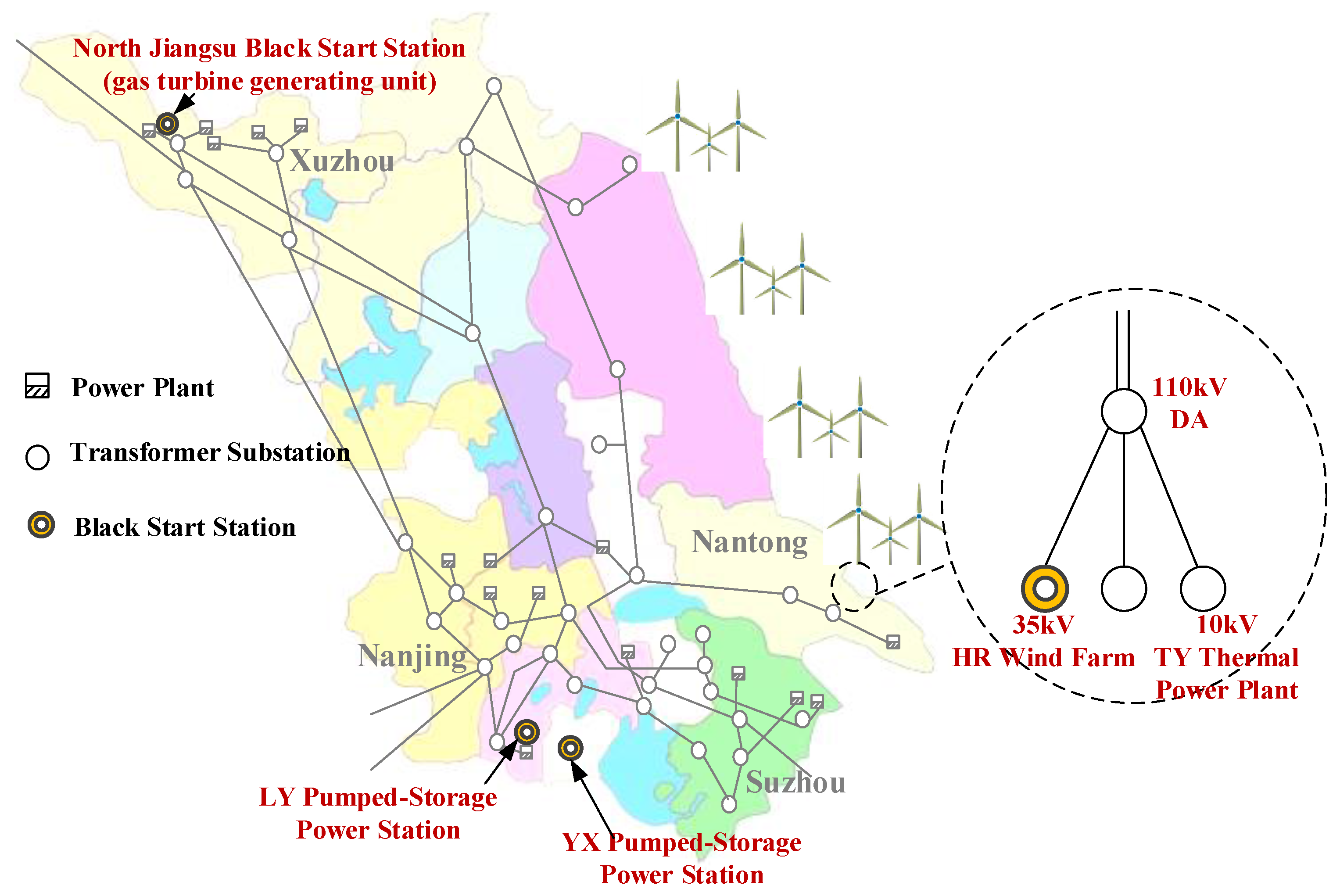
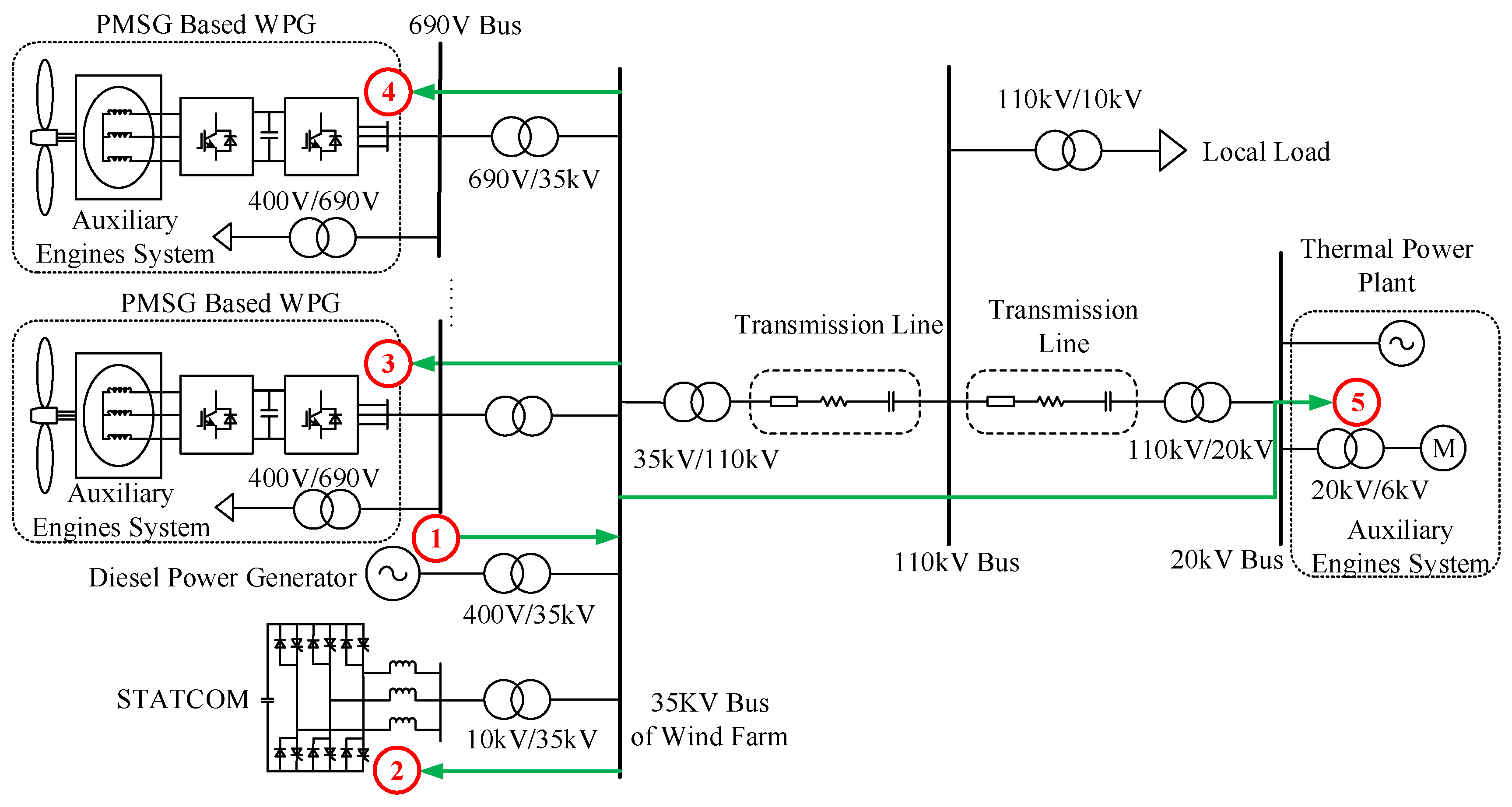
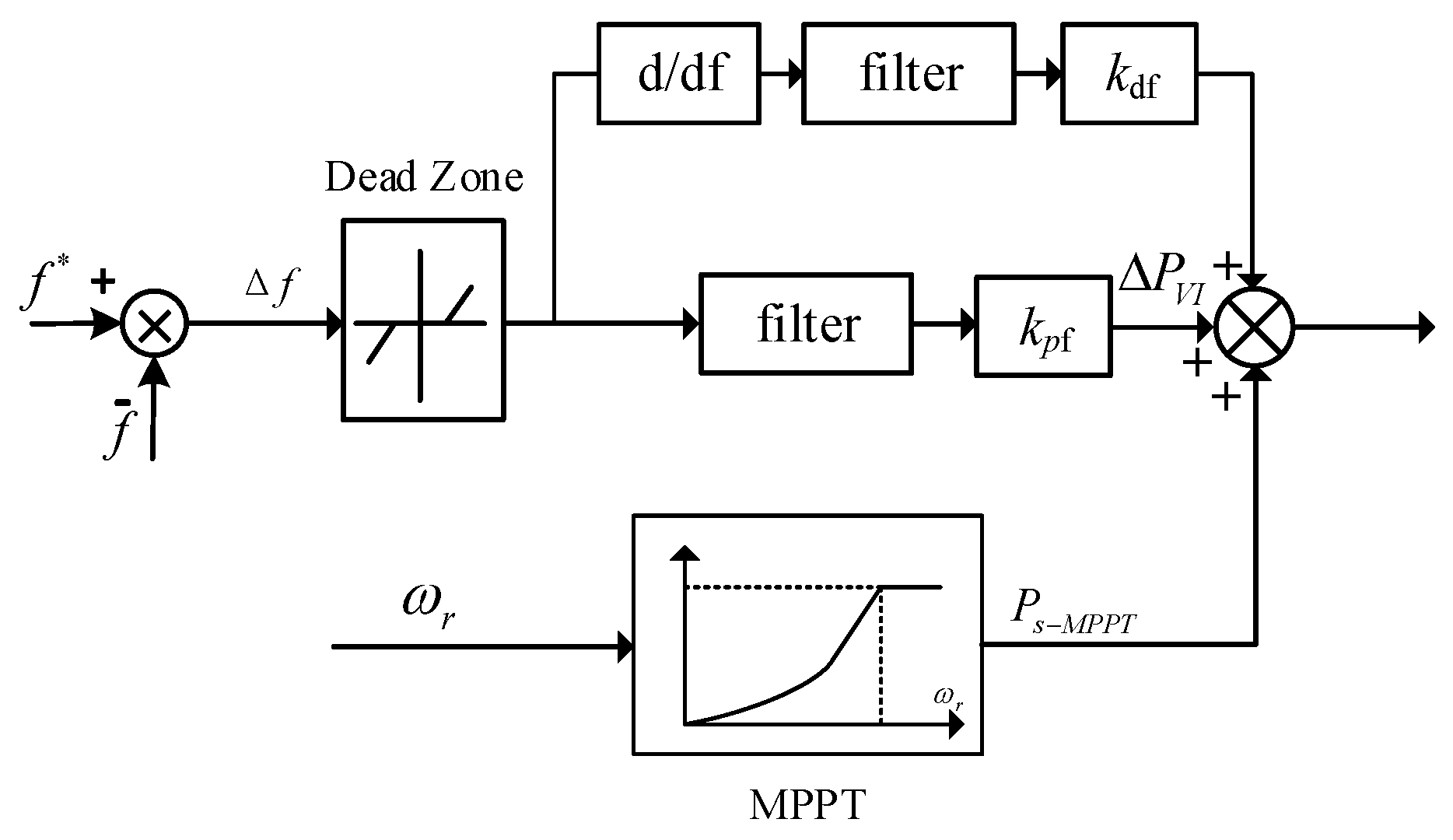


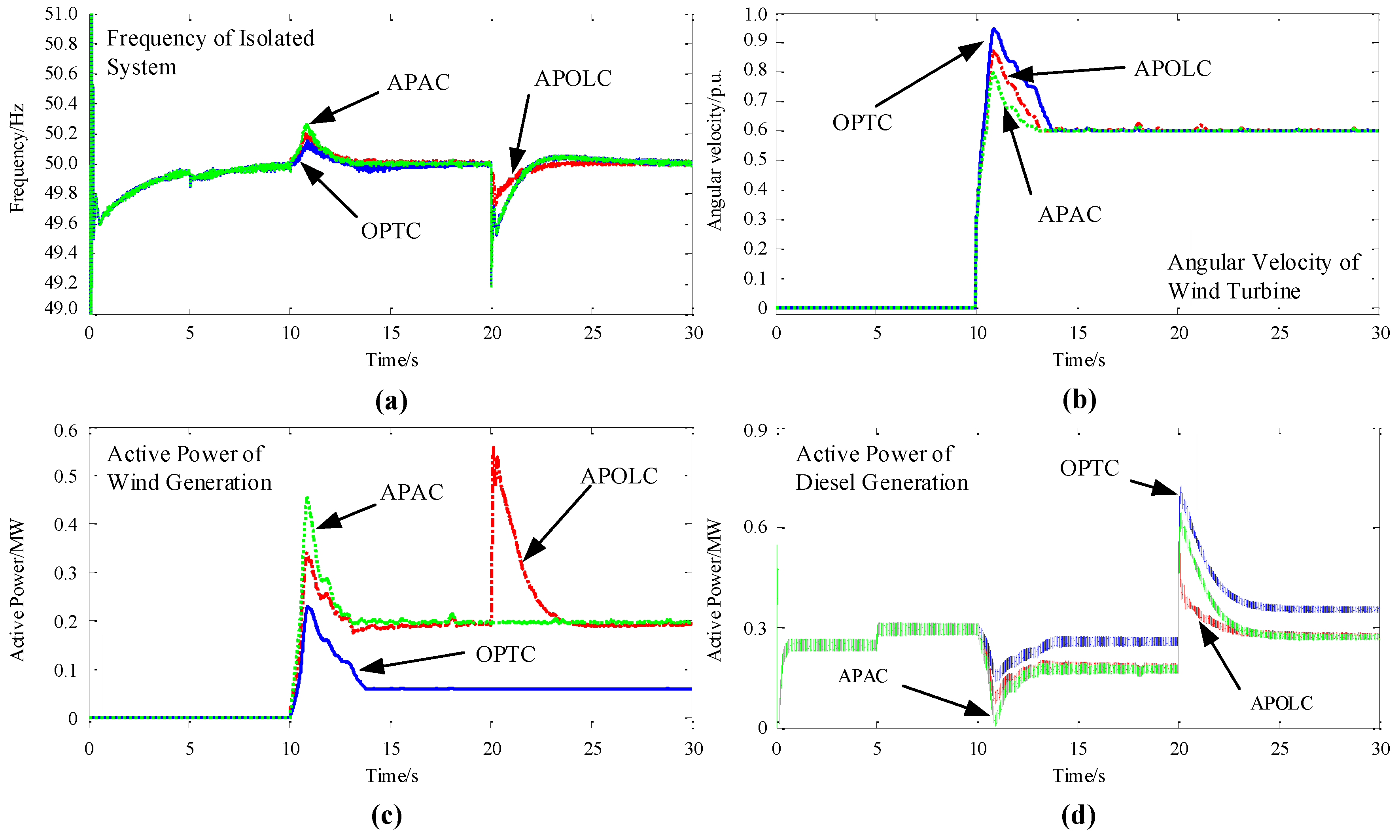
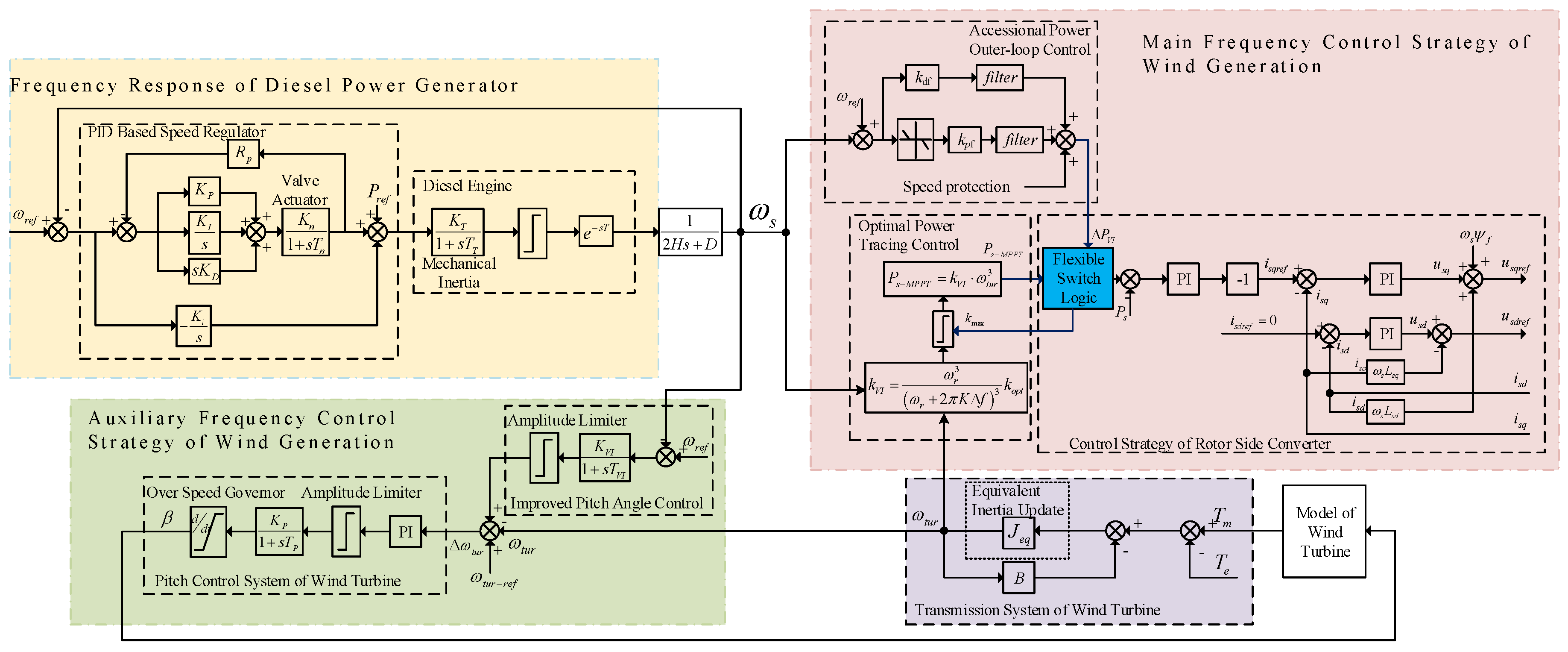

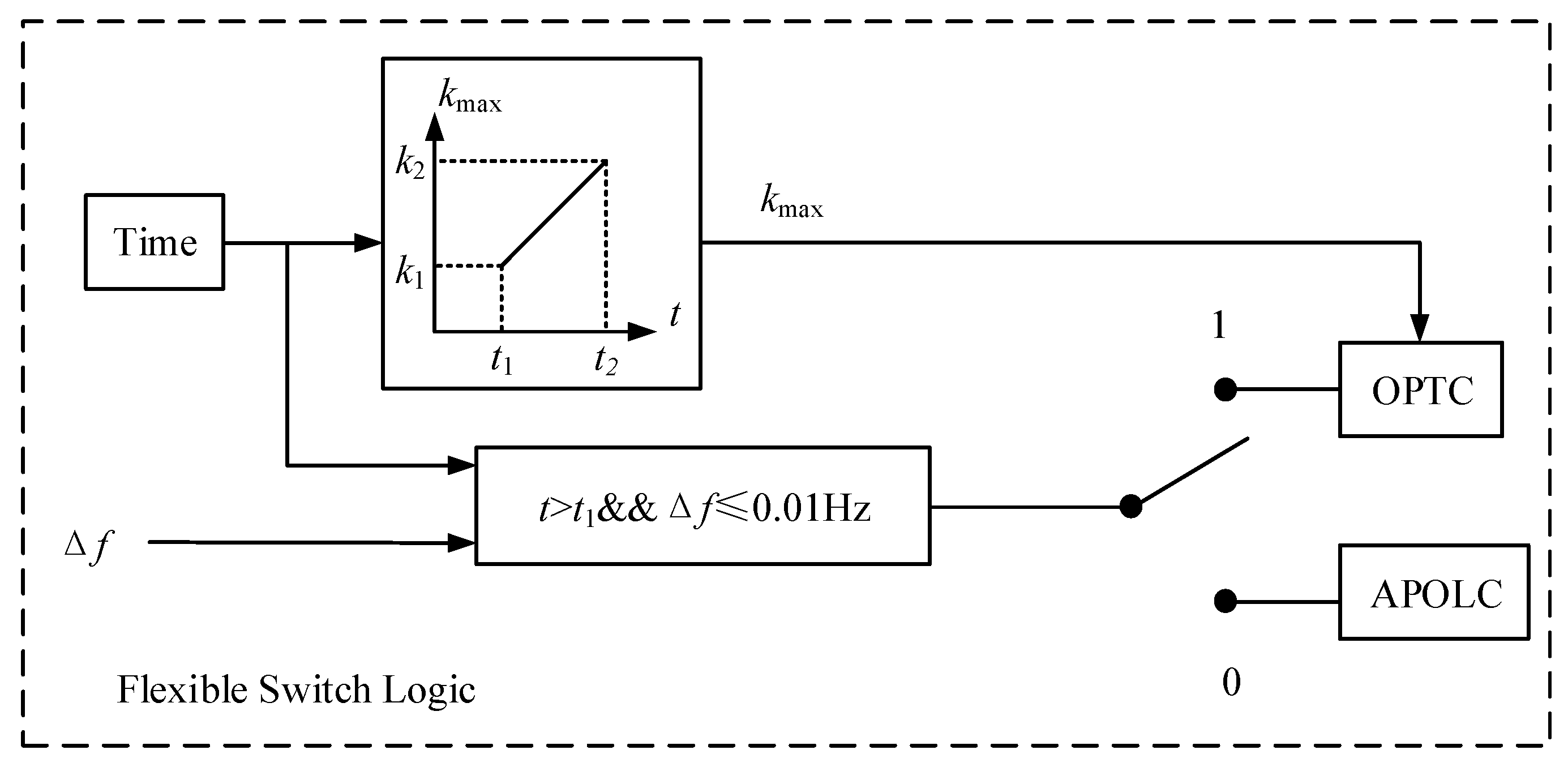
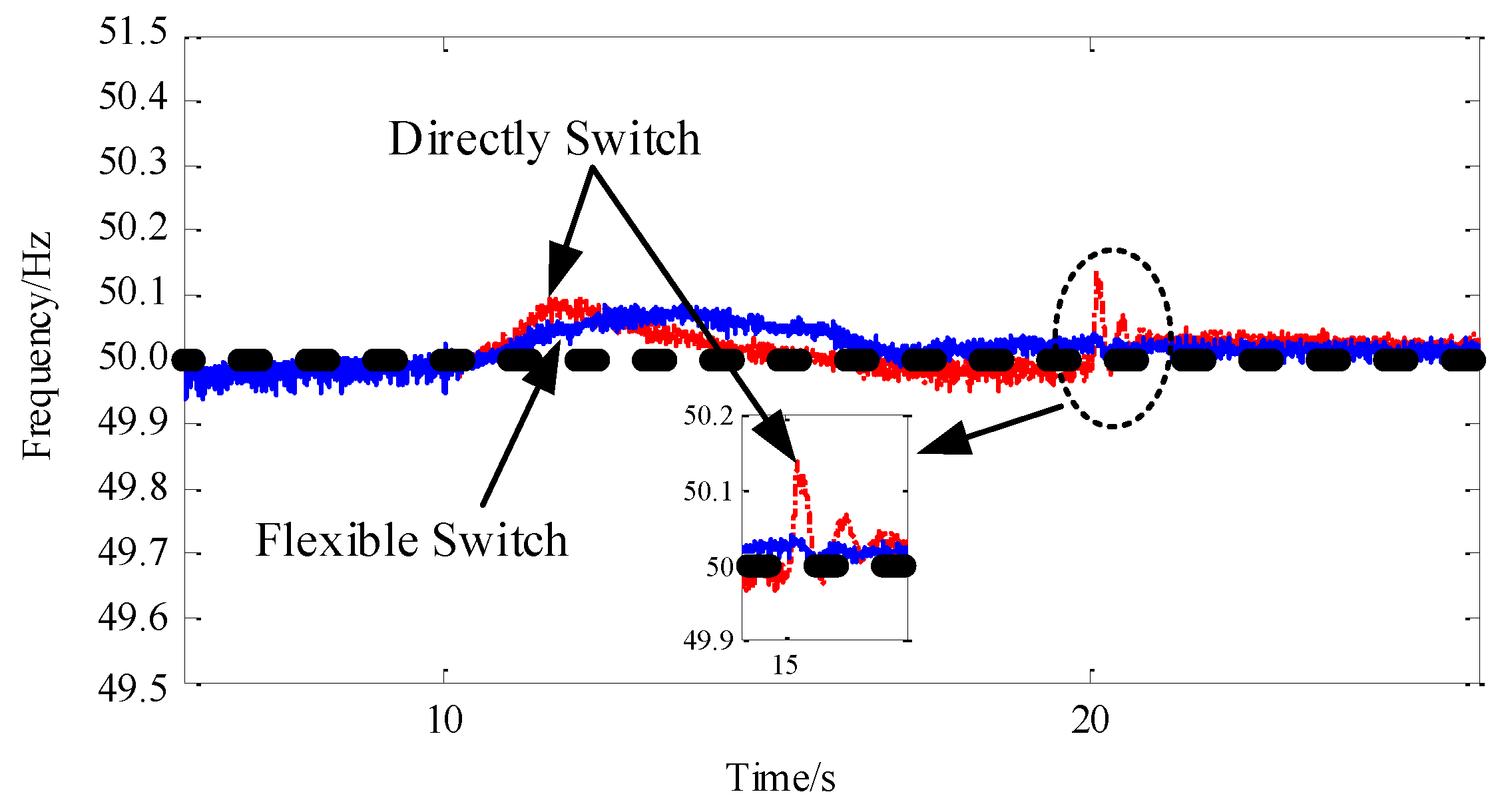
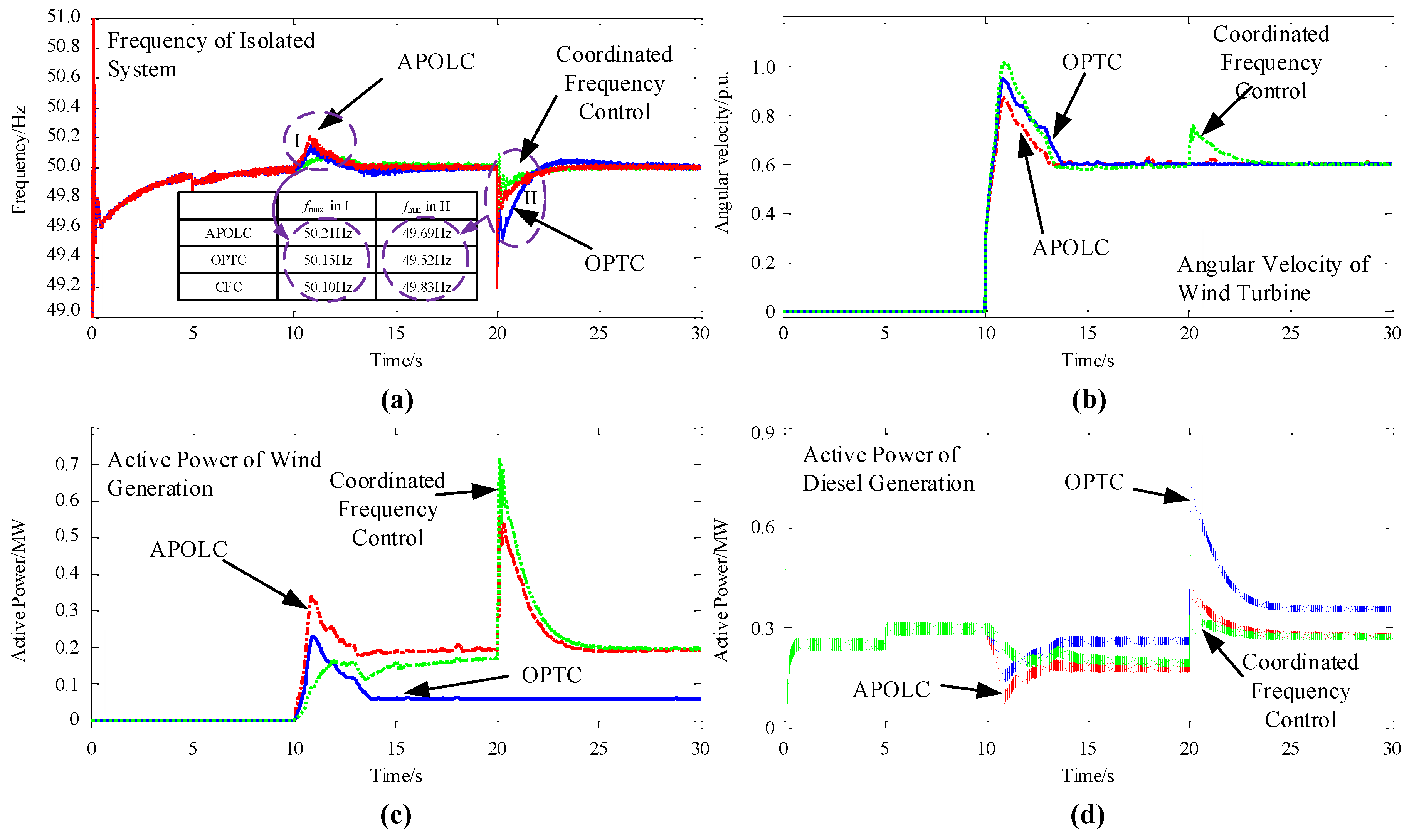
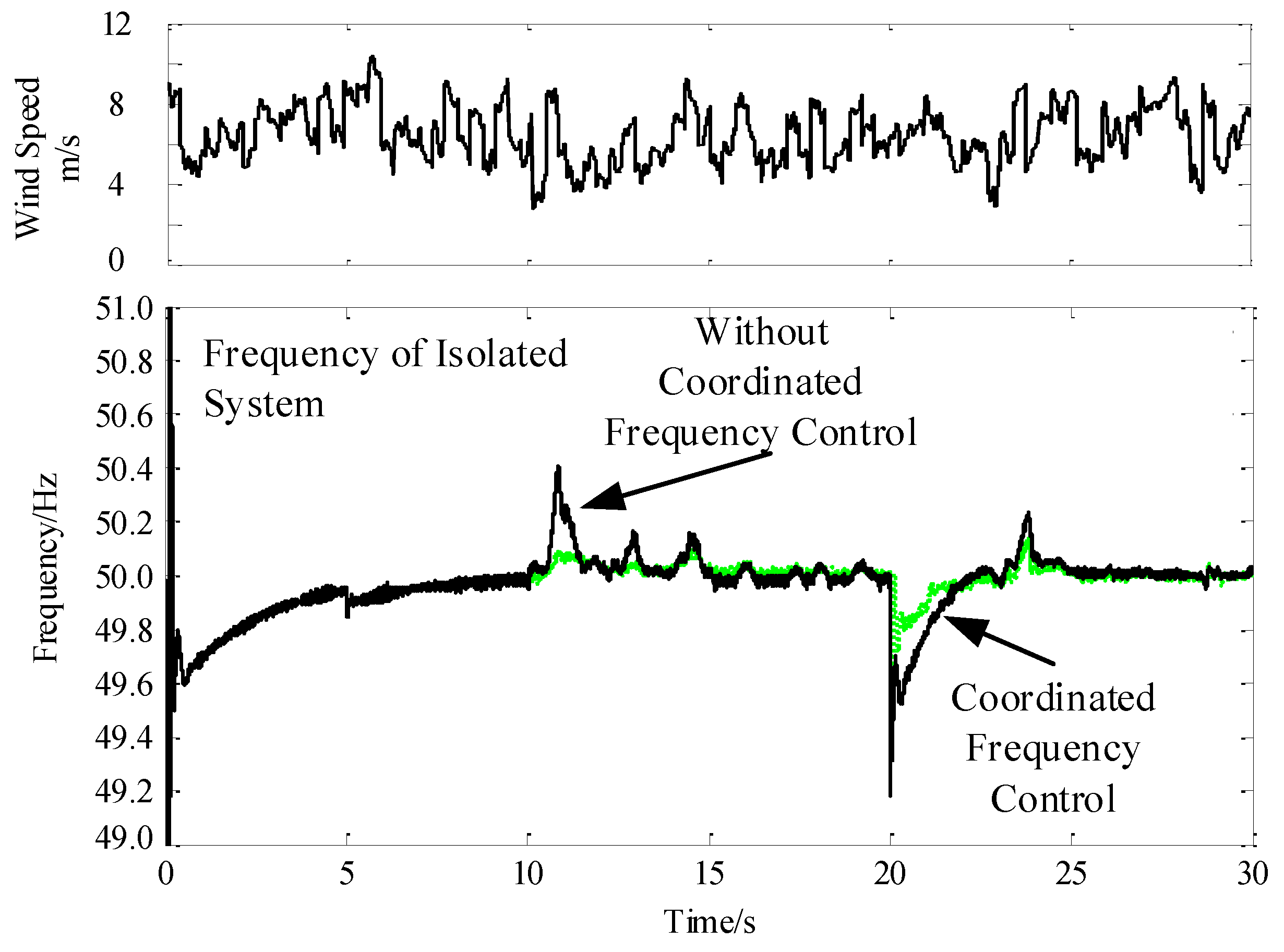
| Parameters | Values | Parameters | Values |
|---|---|---|---|
| Blade RadiusAction (m) | 50 | Number of Pole-pairs | 44 |
| Air Density (kg·m−3) | 1.225 | Stator Resistance (p.u.) | 0.017 |
| Rated Capacity (MVA) | 1.5 | D-axis Inductance (p.u.) | 0.5 |
| Rated Voltage (kV) | 0.69 | Q-axis Inductance (p.u.) | 0.5 |
© 2017 by the authors. Licensee MDPI, Basel, Switzerland. This article is an open access article distributed under the terms and conditions of the Creative Commons Attribution (CC BY) license ( http://creativecommons.org/licenses/by/4.0/).
Share and Cite
Tang, Y.; Dai, J.; Wang, Q.; Feng, Y. Frequency Control Strategy for Black Starts via PMSG-Based Wind Power Generation. Energies 2017, 10, 358. https://doi.org/10.3390/en10030358
Tang Y, Dai J, Wang Q, Feng Y. Frequency Control Strategy for Black Starts via PMSG-Based Wind Power Generation. Energies. 2017; 10(3):358. https://doi.org/10.3390/en10030358
Chicago/Turabian StyleTang, Yi, Jianfeng Dai, Qi Wang, and Yixin Feng. 2017. "Frequency Control Strategy for Black Starts via PMSG-Based Wind Power Generation" Energies 10, no. 3: 358. https://doi.org/10.3390/en10030358
APA StyleTang, Y., Dai, J., Wang, Q., & Feng, Y. (2017). Frequency Control Strategy for Black Starts via PMSG-Based Wind Power Generation. Energies, 10(3), 358. https://doi.org/10.3390/en10030358





